
The Bisbee Mill is a historic gristmill at 66 East Street in Chesterfield, Massachusetts. Located on the Dead Branch of the Westfield River, the mill complex includes a wood frame mill building, along with its former mill pond, impounded by a dam across the river, and a canal that brought river water to the mill for power. Also included on the property is the site of the Damon sawmill, which was established in 1761, and the Pierce cornmill, which occupied a site north of the Bisbee mill building in 1823. The Pierce mill was moved to the site, from an earlier one that may also be on the grounds of the Bisbee mill complex.

Stanton's Mill is a historic grist mill complex located at Grantsville, Garrett County, Maryland, consisting of five interrelated buildings and structures. The Stanton's Mill building dates from about 1797. It is two stories and constructed of heavy timber frame with a gable roof; an addition was constructed in 1890. The complex includes a stone-faced, mid-19th-century timber crib dam and raceway, natural earthen tailrace, and a small, single-span stone arch bridge, dating to 1813, constructed as part of the National Road. Also on the property is a frame storage building, constructed about 1900.

The Union Mill Complex,, is located at the junction of Milton Avenue and Prospect Street in Ballston Spa, New York, United States. It is a complex of three late 19th-century brick buildings on a 4-acre lot, and the ruins of a dam.

The Lucius Gleason House, also known as Liverpool Village Hall and as the Gleason Mansion, is a historic home located at Liverpool, Onondaga County, New York. It was built about 1860, and is a large two-story, Italianate style, stuccoed brick dwelling. It has a telescoping plan with a two-story, hip roofed main block; followed by a smaller two-story, gable roofed wing; and a 1+1⁄2-story gabled appendage. The Gleason Mansion is now home to the Liverpool Village Museum and Historian's office. Operated by the Liverpool Historical Association, the museum features changing exhibits about local history.

Cold Brook Feed Mill is a historic grist mill located at Cold Brook in Herkimer County, New York. It includes the mill, mill dam, flume, and land on both sides of the stream between the mill and dam. The mill is a simple wood-frame structure built in 1857. The main block is two story, square structure with a shed roof, and attached is a one-story, plus basement, lean-to, added after 1857. It is equipped with the original water powered stone grinder and corn sheller.
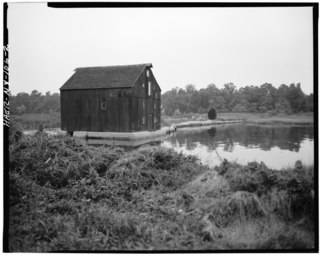
Van Wyck-Lefferts Tide Mill is a historic tide mill located at Lloyd Harbor in Suffolk County, New York. It was built about 1793 and is a 3+1⁄2-story, gable-roofed, timber-framed rectangular building little altered since the early 19th century. The property also includes the earthen mill dam with sluice gates. The Nature Conservancy, which owns the mill, offers free boat tours to the site from May through October.

The Cove Island Houses, although plural in name, is a single house in Cove Island Park, in Stamford, Connecticut. The house was expanded from a first section that dates from 1791, and is now predominantly a Georgian style house with an older wing. It is the only building that is a legacy of the large Stamford Mills complex at the Cove. It was listed on the National Register of Historic Places in 1979. It presently houses administrative offices of Cove Island Park.
Stone Grist Mill Complex is a historic grist mill complex located at St. Johnsville in Montgomery County, New York. The complex consists of the mill, the remains of a stone impoundment dam, the mill owner's house, bar, wagon shed, and hog house. The mill was built about 1835 and is a 30 by 50 feet gable roofed structure constructed of rough cut, native limestone block laid in random ashlar. The mill is now occupied by a bed and breakfast.

Rehoboth is a historic former barn located on Aldridge Road in Chappaqua, New York, United States. It is a concrete structure that has been renovated into a house with some Gothic Revival decorative elements. In 1979 it was listed on the National Register of Historic Places.

The Gray–Watkins Mill or Gray's Mill is a historic structure in Montgomery, in the U.S. state of Illinois. The building was an early turbine mill on the Fox River, and was later used by an automobile parts manufacturer. It was listed on the National Register of Historic Places in 1979.

The Schuyler Mill, also known as the Ford Soybean Plant Complex, is an old mill site that Henry Ford turned into one of his small village industry factories. It is located at 555-600 Michigan Avenue in Saline, Michigan, and was listed on the National Register of Historic Places in 1996.
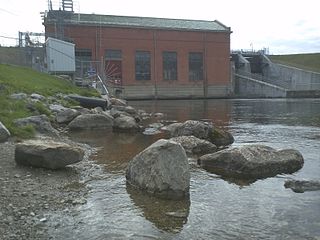
Cooke Dam is a hydro-electric dam on the Au Sable River in Michigan. It was listed on the National Register of Historic Places in 1996 as the Cooke Hydroelectric Plant.

The Luther College Farm was built between the late 1860s and about 1900 on a hill overlooking Luther College near Decorah, Iowa, United States. The farm comprises a complete ensemble of agricultural buildings, dominated by the farm's barns.
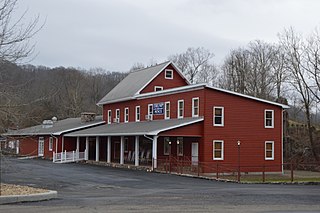
Clinch Valley Roller Mills is a historic grist mill complex located along the Clinch River at Cedar Bluff, Tazewell County, Virginia. The main building was built about 1856, and consists of a 3 1/2-story, timber frame cinder block with later 19th and early-20th century additions. There are additions for grain storage; a saw mill, now enclosed and housing the mill office; the mill dam site with its associated culvert, weirs, flume and turbines; and the 1 1/2-story shop building. The main section is believed to have been rebuilt after a fire in 1884.

Glencoe Mill Village Historic District is a national historic district located at Glencoe, Alamance County, North Carolina. It encompasses 48 contributing buildings and 6 contributing structures built between 1880 and 1882 in Glencoe.
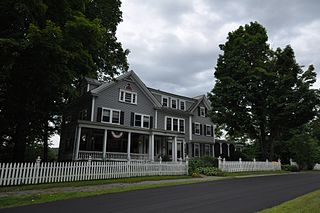
The Dewey House is a historic house at 173 Deweys Mills Road in Hartford, Vermont. Built in 1876 by a local mill owner, and remodeled in 1903, it is a high quality local example of residential Colonial Revival architecture. It was listed on the National Register of Historic Places in 1999.
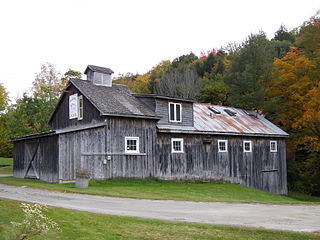
The Old Red Mill is a historic mill complex at Vermont Route 12 and Lovers Lane in southern Northfield, Vermont. Built in 1898, the building houses a nearly intact water-powered grain grinding mechanism from the period. It was listed on the National Register of Historic Places in 1977.

The Old Red Mill and Mill House are a historic 19th-century mill building and residence on Red Mill Drive in Jericho, Vermont. The mill was built in 1856 and enlarged later in the 19th century, accommodating then state-of-the art grain rollers, and was a prominent local business. The house was built in 1859, and is a good local example of Gothic Revival architecture. The mill is now a museum property of the local Jericho Historical Society. The mill building was listed on the National Register of Historic Places in 1972; the listing was expanded to include the house in 1976.

The Thresher Mill is a historic industrial facility on West Barnet Road in Barnet, Vermont. First developed in 1836, it was the last water-powered mill to operate on the Stevens River, lasting into the late 20th century. The property, which includes an original mill dam and a surviving 1872 mill building, as well as archaeological sites of other industrial buildings, was listed on the National Register of Historic Places in 1996. It is now styled Ben's Mill, and is a local museum.






















